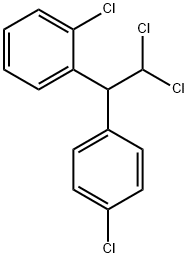| Pharmacological effects |
Mitotan is structurally similar with insecticide DDT and DDD and can selectively cause the atrophy and necrosis of adrenal cortex-zona fasciculata and reticularis cells but without affecting the zona, therefore the secretion of aldosterone will not affected. After the drug administration, the cortisol and its metabolites level in blood and urine decreased rapidly after treatment. At the same time, the in vivo adrenocorticotropic hormone and metabolite products level also decrease rapidly. It is suitable for the treatment of inoperable, functional and non-functional adrenal cortical carcinoma, adrenal tumor, adrenal hyperplasia-caused Klinefelter’s syndrome, adrenal hyperplasia, and the adjuvant therapy of postoperation cortical cancer and tumor-induced Cushing's syndrome.
After oral administration, about 40% of Mitotan is absorbed through the gastrointestinal tract with the remaining 60% of the prototype excreted together with the feces. At a dose of 5~10 g daily, the plasma concentration can be up to 10~90μg/ml, the concentration of metabolites can be up to 30~50μg/ml. At 6-9 weeks after discontinuation, it can be still detected of o-alkyl chloride in the plasma. Mitotan has a high fat-solubility and is mainly stored in fat. The water soluble metabolites discharged from the urine can account for about 25% of the administered dose.
The above information is edited by the chemicalbook of Dai Xiongfeng. |
| Chemical Properties |
It appears as white crystals with the melting point being 76-78 ℃. It is soluble in ethanol and carbon tetrachloride. |
| Uses |
It belongs to antineoplastic agents and can be used for the treatment of adrenal cortical carcinoma. |
| Production method |
It can be prepared from O-bromo-chlorobenzene (see 05820) by the following steps. |
| Category |
Toxic substances. |
| Toxicity grading |
Poisoning. |
| Acute toxicity |
Oral-rat; LD50> 5000 mg/kg; Oral-Mouse LD50> 4000 mg/kg. |
| Flammability and hazard properties |
Thermal decomposition can release toxic chloride fume. |
| Storage characteristics |
Low-temperature, dry and ventilated warehouse. |
| Extinguishing media |
Water, carbon dioxide, foam, powder. |
| Chemical Properties |
Crystalline Solid |
| Uses |
insecticide, antineoplastic |
| Uses |
aminobiphoshphanate for treatment of osteoporosis and Paget's bone disease |
| Uses |
An Antineoplastic. Used as an adrenolytic agent |
| Uses |
Mitotane is an inhibitor of steroidogenesis that suppresses the growth of adrenocortical cells. It blocks the expression of several genes that encode proteins involved in steroidogenesis and disrupts mitochondrial respiratory chain activity in human adrenocortical cells. Mitotane has anti-neoplastic actions, alone or in combination with other compounds, and suppresses cortisol synthesis, although it also has significant toxicity in the gastrointestinal tract and nervous system. It is effective against adrenocortical carcinoma and Cushing’s Syndrome in clinical trials. |
| General Description |
Colorless powder. |
| Air & Water Reactions |
Insoluble in water. |
| Reactivity Profile |
Mitotan dehydrohalogenates with strong alkalis. Simple aromatic halogenated organic compounds are very unreactive; halogenated aliphatic compounds are moderately or very reactive. For both subgroups, reactivity generally decreases with increased degree of substitution of halogen for hydrogen atoms. Materials in this group are incompatible with strong oxidizing and reducing agents. Also, they are incompatible with many amines, nitrides, azo/diazo compounds, alkali metals, and epoxides. |
| Fire Hazard |
Flash point data for Mitotan are not available. Mitotan is probably combustible. |

 China
China






